McGill Newsmakers 2001
According to Arthur C. Clarke and Stanley Kubrick, 2001 was supposed to have been a very different year.
Videophones would be commonplace, space travel would be no big deal and if your computer malfunctioned it wouldn't just result in lost documents -- the machine would actually come gunning for you.
The year, of course, will be remembered for something very different.
We're all still reeling from the events of September 11. While the U.S. and its allies seem to have the bad guys on the ropes with the Taliban toppled from power and Osama bin Laden on the run, a happy ending is still far from guaranteed for either North Americans or Afghans. And tensions between Israelis and Palestinians and between India and Pakistan continue to escalate, threatening us with the very real possibility that 2002 will offer horrific headlines of its own.
The year 2001 will be remembered for a variety of things here at McGill.
It was the year the McGill University Health Centre committed itself to a full disclosure policy in terms of relaying news of medical mishaps to patients. The members of the men's volleyball team also committed themselves to full disclosure -- posing nude for a fundraising calendar.
There were plenty of stars to be seen at McGill as Julia Roberts, Benjamin Bratt, Katie Holmes and Bridgit Fonda were among the Hollywood types to be spotted on campus when three Hollywood films all shot scenes here in the late spring. And on the subject of stargazing, an asteroid was officially named after McGill in 2001, thanks to the efforts of former student and ace astronomer David Levy.
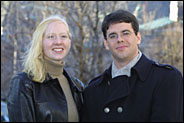 Kimberley Brownlee and François Tanguay-Renaud
Kimberley Brownlee and François Tanguay-RenaudPHOTO: Owen Egan |
|
The women's soccer and rugby teams challenged for national championships, Kimberley Brownlee and François Tanguay-Renaud won Rhodes Scholarships and Opera McGill wowed critics during its sold-out performances of Mozart's Le Nozze di Figaro.
Natural resource sciences graduate student Mauro Pezzente took pleasure in the fact that Spin Magazine ranked his band Godspeed You Black Emperor! ahead of Madonna in its listing of the most influential musical acts.
Other McGill students took to the stage wearing even less clothing than Madonna typically sports, in order to raise funds for children with HIV in the Management Undergraduate Society's annual Phassion show.
A new on-campus fitness program targeted at staff became an instant hit, as was the Faculty of Medicine's new Mini Med School. Some of McGill's top medical professors skipped the jargon and offered their plain-spoken expertise to ordinary folks seeking a deeper understanding of how our bodies work. The result was enthusiastic crowds and a long waiting list of people who want to sign up for the program.
Several new research centres received the green light in 2001, including the Centre for Interdisciplinary Research in Music Media and Technology, the International Centre for Youth Gambling Problems and High-Risk Behaviours and the Centre for Research on Language, Mind and Brain.
The new Intellectual Property Policy got the go-ahead after months of debate, while Chapters got the heave-ho as the manager of the McGill Bookstore for its less-than-stellar performance.
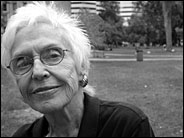 Michelle Tisseyre
Michelle TisseyrePHOTO: Claudio Calligaris |
|
Radio and TV personality Michelle Tisseyre set an unofficial McGill record for the longest interruption in undergraduate studies. Once known as Quebec's Ed Sullivan because of the popularity of her TV variety show in the 1950s, Tisseyre resumed the McGill studies she abandoned in 1936 when she moved away from Montreal with her new husband.
The University placed fourth among medical/doctoral universities in the annual Maclean's ranking of Canadian universities, but we scored high in the categories that are arguably the most important; the ones pertaining to the quality of our faculty and our students. According to the magazine, McGill students win more awards than do their counterparts at any other comparable school and they tie with students at Queen's for being the most likely to successfully complete their studies. McGill professors ranked second among all universities for their success in winning national awards.
Also this year, the firm Research Infosource declared that McGill professors attracted more funding for their research projects, on average, than professors at any other Canadian university.
McGill's professors made plenty of news with what they did with that funding.
As we've done for the last three years, we've combed through hundreds of news stories about McGill and its people that were published or broadcast by newspapers, magazines, TV shows and radio programs in 2001. We've spotted references to McGill in everything from the Arizona Republic to Die Zelt.
And, in this age of top ten lists, we've put together one of our own -- the ten research stories that were covered the most by the world's press.
Before we dive in to the results, there are a few things to bear in mind. In order to qualify, a news story had to mention a McGill researcher by name, had to name McGill or a McGill-affiliated institution and had to offer some sense of what the researcher actually did.
We only count an appearance in a newspaper or other media form once. Medical ethics scholar Margaret Somerville, for instance, is often sought out by the National Post for her views on issues related to her area of expertise. For our purposes, we would only count such an interview one time.
The following list, if it measures anything at all, illustrates how many different news editors deemed various researchers' work significant enough to feature stories about it.
Professor Freda Miller from the Montreal Neurological Institute takes the top spot with appearances in 60 news media ranging from the Los Angeles Times to Canada AM to The Economist. Miller was named as a personality of the year by both La Presse and l'Actualité.
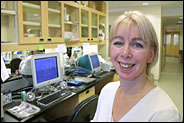 Freda Miller
Freda MillerPHOTO: Owen Egan |
|
What garnered Miller all this attention was the groundbreaking work her lab did in the area of stem cell development. Miller and her team discovered that adult stem cells culled from rat skin seem to be versatile enough to become fat, muscle or even brain cells.
The finding was especially noteworthy because of the controversy surrounding the use of embryonic stem cells -- U.S. president George W. Bush placed new restrictions on research involving their use. Stem cells are invaluable because of their potential for replacing a wide variety of damaged cells throughout the body.
Miller's team decided to devote two months to investigating the then far-fetched notion that stem cells could be found in skin when one of the lab's members, Jean Toma, put forward the idea.
"But it worked right from the beginning," Miller told The Gazette. "Every step of the way it's been an 'I can't believe that it's true' experience."
Second place goes to Professor Margaret Somerville of the McGill Centre for Medicine, Ethics and Law. Somerville's recent book, The Ethical Canary: Science, Society and the Human Spirit, explored the moral dilemmas resulting from the way in which scientific advances are affecting the practice of medicine.
Forty-eight news media, including Newsweek, The Globe and Mail and CBC Newsworld's Hot Type, featured stories quoting Somerville about her book's themes.
For her part, Somerville was happy to comply as she is anxious to get people talking about the issues The Ethical Canary explores, such as cloning and xenotransplantation. "We face questions that no generation in human history has had to contend with," Somerville told the Reporter.
Professor Robert Zatorre from the Montreal Neurological Institute comes in next with 47 appearances in different news media. The Washington Post, The Daily Telegraph and CBC Radio's As It Happens all covered work done by Zatorre and his former graduate student Anne Blood.
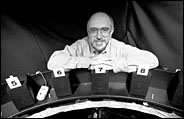 Robert Zatorre
Robert ZatorrePHOTO: Owen Egan |
|
The pair used positron emission tomography to determine which parts of the brain are active when music is played that gives listeners "shivers down the spine" -- music that the study's research subjects found especially pleasurable. The brain bits that reacted the most turned out to be located in the same region of the brain that also responds to food and sex.
Zatorre's research efforts obviously strike the right chord with news editors. This is the fourth year in a row that he has made our top ten list.
Professor Michael Kramer from the Departments of Epidemiology and Biostatistics and Pediatrics is in fourth place. His research was covered by 37 news media, including USA Today, Newsday and U.S. News and World Report.
Kramer led a study that probed the benefits of breast-feeding and that followed over 16,000 mothers and their babies. The study compared women who breast-fed their babies a lot with moms who switched to bottle-feeding early on. The kids who were breast-fed were less likely to experience intestinal infections or eczema.
Kramer told U.S. News and World Report that the researchers hope to continue to track the mothers and children to see if extended breast-feeding has an effect on "even more important areas like intelligence, allergies, growth, obesity, and blood pressure."
Professor Mark Ware from the McGill Pain Centre takes fifth spot with appearances in 35 different news media, among them, CBC Radio's Quirks and Quarks, The Medical Post and Le Journal de Montréal.
We're reasonably certain he is the only McGill researcher whose work has been covered by the Cannabis Times. We think he is also the only McGill professor who has been asked during a press conference if he has ever smoked a joint. "We're talking about human suffering. We're talking about using cannabis as medicine. Next question, please," Ware responded.
Ware is leading a McGill research team that is examining whether or not smoking marijuana can provide effective relief from chronic neuropathic pain. It's the world's first peer-reviewed clinical trial examining the effects of smoked cannabis among patients that isn't exclusively focused on HIV or multiple sclerosis. "Someday, marijuana is going to join the family of drugs used for pain management," Ware told the Montreal tabloid, Hour.
Professor Peter Barss from the Department of Epidemiology and Biostatistics turned up in 34 news media including National Public Radio's Talk of the Nation, Wired and The Boston Globe. The attention was for work that Barss published way back in 1984 -- "Injuries Due to Falling Coconuts."
The research netted Barss an Ig Nobel Prize, awards that go to scientists and scholars who, according to Ig Nobel organizers, "have done remarkably goofy things -- some of them admirable, some perhaps otherwise."
Barss accepted the ribbing attached to winning an Ig Nobel with good humour, but stressed that his research wasn't as silly as it sounds. In tropical climes where coconut trees are abundant, falling coconuts really are a health hazard. The coconuts are heavy and fall from quite a height -- the impact is enough to tear a hole through the roof of a car.
Today, Barss monitors water-related deaths in Canada and says the joke-filled Ig Nobel ceremony was a welcome respite. "Every day I'm receiving data that's quite tragic. It's nice to have an opportunity for a lot of laughs."
Professor Christina Wolfson from the Department of Epidemiology and Biostatistics attracted the attention of 33 news media last year for research she led. Wolfson's work was covered by the Los Angeles Times, USA Today and The Toronto Sun.
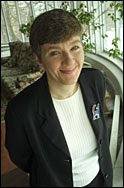 Christina Wolfson
Christina WolfsonPHOTO: Owen Egan |
|
Wolfson and her colleagues examined the life expectancy of patients with dementia and uncovered the fact that these patients often die within three years of being diagnosed -- much sooner than doctors had previously thought.
"We know these are terrible, rapidly progressing, devastating diseases. But the way we've looked at the data, it's even worse than we thought," Wolfson told the Associated Press.
She said the problem with earlier research is that it didn't include people whose disease progressed rapidly. As a result, survival time for Alzheimer's and other forms of dementia was overestimated.
Sometimes even scientists themselves are startled at what they turn up. Biochemistry professor Nahum Sonenberg and his team are a case in point.
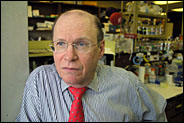 Nahum Sonenberg
Nahum SonenbergPHOTO: Owen Egan |
|
While studying a protein known as 4E to see if it played a role in the development of cancer, they stumbled onto the fact that the protein, at least in mice, seems to turn white fat, the kind the body stores, into brown fat, the kind the body burns. Sonenberg's team eliminated the protein's inhibitor in lab mice. The result was 50 per cent less accumulated body fat in the animals.
"The whole point was to study cancer. And now we're studying obesity instead," PhD candidate Francis Poulin told Canadian Press.
Twenty-five news media took note, including Le Devoir, The Toronto Star and The Globe and Mail.
In ninth place is physics professor Victoria Kaspi for cosmic detective work spanning the centuries. Working with McGill's Mallory Roberts and other astronomers, Kaspi used the Chandra X-ray observatory and its orbiting telescope to locate a pulsar that was formed when a massive star exploded in 386 CE, an event that was witnessed and chronicled by Chinese astronomers.
Kaspi's team noted that the characteristics of the pulsar, a rapidly spinning remnant of a star that sends out beams of energy, correspond with the 1,615-year-old records of the Chinese astronomers. "We'll never know 100% what [the Chinese] saw -- it could have been a comet -- but it all fits so nicely," Kaspi told the Reporter.
Her work drew the attention of 24 news media, including The New York Times, The Washington Post and National Public Radio's All Things Considered.
Professor Samy Suissa from the Department of Epidemiology and Biostatistics is in tenth place. His work as part of a team of scientists exploring rumoured links between shots for hepatitis B and multiple sclerosis was reported on by 23 news media, including CBC TV's Health Matters, La Presse and MSNBC Online.
Suissa's study looked at whether vaccinations, including hepatitis B, tetanus and flu, trigger a flare-up of symptoms in patients with MS. The researchers concluded that vaccination doesn't appear to increase the risk of relapse.
"There wasn't even a little hint that something is going on. For me, the books are closed with respect to this issue," Suissa told the Associated Press.
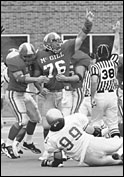 Randy Chevrier
Randy ChevrierPHOTO: McGill Sports Information |
|
McGill students who wound up in the pages of newspapers and in other news media often last year included Audrey Best, former Quebec Premier Lucien Bouchard's wife and a recent graduate of the Faculty of Law. Physical education student Kim St. Pierre, a goaltending star with the Canadian national women's team, also attracted attention.
In top spot, though, was McGill Redmen football standout Randy Chevrier, who parlayed an all-star career at McGill into a job in the National Football League, becoming one of the very few products of the Canadian university football system to make it to the NFL.
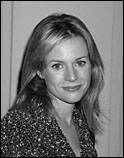 Jessalyn Gilsig
Jessalyn Gilsig |
|
McGill graduates who garnered a lot of press coverage in stories that mentioned their McGill links, included Chancellor Richard Pound who lost out in his bid to become the new president of the International Olympics Committee.
Actress Jessalyn Gilsig, a member of the cast of the popular TV show Boston Public, also drew a lot of attention. Gilsig got her start doing voiceovers for cartoons while studying English at McGill.
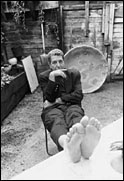 Leonard Cohen
Leonard Cohen |
|
Musician/poet Leonard Cohen caused a splash when he released his first new CD in almost a decade. Cohen's musical career began as a McGill undergraduate when he led a country music group known as the Buckskin Boys.
Donna Hayes, the new CEO of Harlequin Enterprises Ltd, the publisher of romantic pot boilers that sell millions of copies of books that precious few people own up to reading, also made headlines. She promises, among other things, steamier love scenes.
The McGill-trained Nortel duo of John Roth and Frank Dunn also earned plenty of notice. Roth went from being the CEO of the Year and a media darling to becoming a fixture on the dart boards of scores of disgruntled Nortel investors as the value of the company's shares plummeted in 2001.
Roth is making way for Dunn, Nortel's new CEO, whose appointment caused some surprise, mostly because he has been a low-key and longtime Nortel employee, and not the sort of high-profile outsider that many observers expected Nortel to hire. The National Post ran a cheeky article about Dunn that noted that many of his old McGill classmates couldn't remember the guy who is about to become one of Canada's most important corporate leaders.

